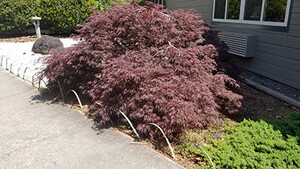The Zen Garden elements present a "mindscape" in which the raked sand might represent ripples or waves on the water of the sea or lake, the pruned bushes wooded hills and mountains in the distance, and the large rocks islands and cliffs. Feel free to step into the garden and rake your own pattern, opening your mind to the process and excluding all outside thoughts.
The Zen Garden sits in front of the CARE building and was originally created in 2011 by Richard Laxar and Mary Ellen Walkama in an area that had become overgrown with various plants and monkey grass. Because he had traveled in Japan and taken a seminar on Japanese Garden Design, Richard recognized that the elements for a traditional Buddhist garden were already in place – rocks, bushes and a Japanese lantern. The raked sand and a lovely weeping Japanese maple were added, inspired by karesansui (dry landscape) gardens at many Buddhist temples in Japan, some dating from the 6th century. The Japanese maple that defined the edge of the garden recently died and will be replaced this fall, along with replacement of some of the ferns and plants at the back of the garden.
The elements of the Zen garden present a "mindscape" in which the raked sand might represent ripples or waves on the water of the sea or lake, the pruned bushes might represent the wooded hills and mountains in the distance, and the large rocks can represent islands and cliffs. The act of raking the gravel or sand can be a meditative process that is also creative. The Ishidoro (stone lantern) also originates from the 6th century. A burning candle within it symbolizes the teachings of Buddha, the light that helps us overcome the darkness of ignorance. Please enjoy the garden by sitting or standing back from it, inhaling a visual deep breath. Feel free to step into the garden and rake your own pattern, opening your mind to the process and excluding all outside thoughts.
If you would like to help with the Zen garden, please contact Barbara Beaman or Richard Laxar.

